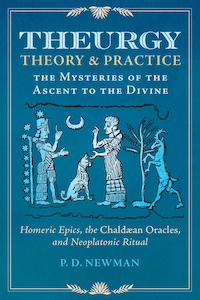
Theurgy: Theory & Practice: The Mysteries of the Ascent to the Divine, by P.D. Newman
Inner Tradition, 164411836X, 224 pages, December 2023
Theurgy is a Neoplatonic form of ritual magic in which the practitioner seeks mystical union with a divine being. The term theurgy, which means “to work with deity”1 in Greek, was first coined in the Chaldæan Oracles, a fragmented collection of dactylic hexameter verses, written in Homeric Greek, that were believed to have been channeled directly from the gods by either Julian the Chaldæan, or his son, Julian the Theurgist, during the late second century CE.
In Theurgy: Theory & Practice: The Mysteries of the Ascent to the Divine, author P.D. Newman, who has practiced theurgy for over two decades and is also a member of both the Masonic Fraternity and the Society of Rosicrucians, supplies a solid scholarly background on the development of theurgical practices. Even though the Chaldæan Oracles are the fundamental text on theurgy, he argues that the practice itself can be traced all the way back to Homeric times.
In Part I, he demonstrates how the ancient Greek version of shamans, called iatromanteia (“healer-seers”), and the Presocratic philosophers laid the foundation for theurgical practices.
“Theurgy,” Newman explains, “is a process of anabasis or magical ascent whereby practitioners, such as the Neoplatonists…achieved henosis or mystical union with a deity, the Demiurge or the One,” while katabasis is “a dreamy descent to the domain of the dead and to the dark goddess who rules over that realm.”2
Plato and his followers aspired to ascend through the planetary spheres and unite with the One, the paternal Monad, using theurgical practices, while their predecessors, the iatromanteia (“healer-seers”) and Presocratic philosophers, sought Underworld descent, or katabasis, and union with the terrifying goddess that ruled there.
“For the Platonists, katabasis was understood as the descent of the soul into a body upon incarnation,” Newman says. “Hades, additionally, was allegorized and viewed as the very world that we, as embodied beings, inhabit.”3
In Plato’s teachings, the body (soma) is a grave (sema), and a prison for the soul. Plato’s famous “Allegory of the Cave” in the Republic demonstrates how the focus of theurgical practices shifted from the Underworld to the heavens. “The goal of the theurgist is not unlike that of the prisoner in the cave—to escape the sensible world of duality and penetrate the realm of ultimate, unitive reality above,” Newman says.4
I was fascinated to learn that the Sicilian stratovolcano Mount Etna was believed to be an entrance to Hades, and sacrifices to the goddess of the Underworld were thrown into the mouth of this fiery cauldron. According to legend, the iatromantis (healer-seer) Empedocles threw himself into the volcano to prove his divinity, and it erupted, vomiting out a single bronze sandal. Through self-immolation, Empedocles achieved henosis (mystical union) with the goddess Hecate. A single bronze sandal is one of her attributes as the Lady of Tartaros in the Papyri Graecae Magicae, and the Greeks associated bronze with the Underworld. This was a profound insight for me because I didn’t know that Hecate was associated with volcanoes, and this explains her fiery epithets.
Part II explores possible theurgic elements in Homer’s Odyssey and Iliad. In Chapter 6, titled “Porphyry’s On the Cave of the Nymphs,” Newman demonstrates how philosophers often saw Odysseus as a spiritual hero, on a path of return to his celestial abode. For example, he says the Pythagoreans interpreted the song of the sirens to be the music of the celestial spheres, which is so beautiful it has the power to “lift the soul in its theurgic ascent to the Good,”5 and the Neopythagorean philosopher Numenius of Apamea saw “Odysseus as escaping genesis, the realm of ‘becoming,’ symbolized by the waters of Poseidon.”6
I loved this chapter, and the passages about Witch Queen Circe really blew my mind. According to the Neoplatonic philosopher Porphyry of Tyre, Circe symbolizes the cycle of metensomatosis, or reincarnation, in which eternal souls change bodies like clothes. Aiaia, the island over which she rules, is part of the land of the dead. Bewitched by the pleasures of the flesh, Odysseus’s men drink the witch’s brew and are reborn as beasts. Only Odysseus himself, who is on a path of ascension, is immune to her powers. Now that my perspective has been shifted to view the Odyssey as the tale of a hero’s apotheosis, I will never read it the same way again.
Part III, titled “Theurgic Telestikē,” analyzes the practice of animating cult statues. This section was the most relevant for me because I have written my own rituals to awaken my deity statues in the past and I am looking to incorporate more traditional methods of doing so in order to infuse my rituals with historical authenticity. I also recently wrote a ritual to enliven a scrying mirror for Lilith, because in Jewish folklore she was believed to inhabit mirrors. One passage in particular really resonated with my intention, in which Newman quotes Plotinus, who compared the consecrated cult statue to “a mirror able to catch some image of it.”7
In order to animate the statue, a sympathetic link is created with “theurgic talismans called synthēmata (tokens) and symbola (symbols),”8 which are similar to the planetary correspondences assigned to plants, animals, and minerals in natural magic. However, there is more to statue vivification than simply following a list of correspondences recognized by the intellect. Rather, the tokens and symbols help the theurgist align with the deity by making their divine essence become conscious, or awakened, within themselves, especially if they have psychoactive properties that alter one’s consciousness. For example, in fragment 224 of the Chaldæan Oracles, the goddess Hecate instructs the theurgist to animate her statue with wild rue, or Syrian rue, an entheogenic plant that the Roman naturalist Pliny the Elder associated with vision, which is still burned today in the Middle East to repel the evil eye.
My devotion to Hecate inspired me to learn more about theurgy because of her exalted status in the Chaldæan Oracles, in which she is referred to as the World Soul, or at least she is according to my copy, translated by Ruth Majercik. Before reading this book, I wasn’t aware that there is conflicting scholarship about whether or not this epithet applies to her, and I was surprised to find that Newman presents the argument that Hecate is not herself the anima mundi, or World Soul, because her position in the Chaldæan hierarchy is too elevated.
“Indeed…in the Oracles, Hecate is said to be the cause of soul—but not soul itself, “Newman says. “Rather, Hecate is acknowledged as a goddess of liminality who exists in the space between two realms, such as she served when acting in the role of psychopomp for Persephone in the Eleusinian mysteries.”9
In an initiatory dream I received over a decade ago, Hecate stabbed me in my right side with her dagger and pomegranate juice flowed from the wound. “You are Persephone,” she said. Several years later, the dream made more sense to me when I read Fragment 51 of The Chaldean Oracles: “Around the hollow of her right flank a great stream of the primordially-generated Soul gushes forth in abundance, totally ensouling light, fire, ether, worlds.”10 If Hecate is so elevated that she transcends the epithet of World Soul, then I wonder if perhaps her lowest aspect, the maiden Persephone, should in fact hold that title.
Theurgy: Theory & Practice is an astounding work that combines shamanism, various schools of Greek philosophy, and theurgical praxis that can be integrated by modern occultists. The many branches of Greek philosophy can be an overwhelming topic to explore, but Newman does an excellent job of diluting the common theurgical elements, and a wealth of information is condensed into under 200 pages. Both modern theurgists and devotees of Hecate will appreciate this work, especially if they are interested in learning more about her significance in the Chaldæan Oracles.

Rachel Christina McConnell is a witch, tarot reader, intuitive astrologer, and writing spider. She holds an MFA in Fiction from Columbia University in the City of New York. Her short stories have appeared in Dark Moon Lilith Press and Minerva Rising Press’s The Keeping Room. Links to her publications are available here: https://rachelchristinamcconnell.wordpress.com
